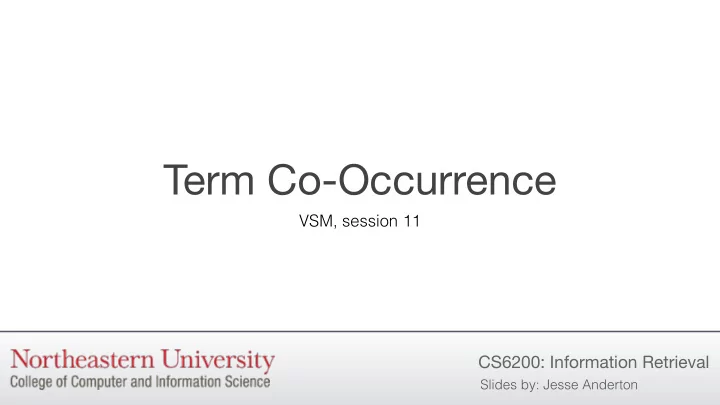

Term Co-Occurrence VSM, session 11 CS6200: Information Retrieval Slides by: Jesse Anderton
Query Expansion We can add words with similar meanings to query terms, e.g. from stem classes or a thesaurus. We can also add words which commonly co-occur with query terms, on an assumption that they must be related to the same topic. Medical Subject Headings Thesaurus (NIH)
Term Association Measures Measure Formula Mutual Information n ab (MIM) n a · n b Expected Mutual Inf. � � There are many measures of term co- n ab n ab · log N · (EMIM) n a · n b occurrence. Chi-square N · n a · n b ) 2 ( n ab − 1 ( Χ 2 ) We’ll summarize them here, and then n a · n b Dice’s coefficient examine what each means and how n ab (Dice) n a + n b they differ. Measures of co-occurrence. * These formulas are partial, but rank- equivalent to the full formulas.
Dice’s Coe ffi cient Dice’s coefficient , aka the Sørensen index , is used to compare two random samples. In this case, we compare the population of documents containing terms a and b to the populations containing a and containing b . dice ( a , b ) = 2 · n ab n a + n b n ab rank = n a + n b
Pointwise Mutual Information Pointwise mutual information is a measure of correlation from � p ( a , b ) information theory. � pmi ( a , b ) := log p ( a ) p ( b ) � n ab � N = log n a n b N N = log N + log n ab n a n b = n ab rank n a n b
Expected Mutual Information Expected mutual information corrects a bias of pointwise mutual information toward low frequency terms. emim ( a , b ) ∝ P ( a , b ) · log P ( a , b ) P ( a ) P ( b ) � � = n ab n ab N log N · n a · n b � � n ab rank = n ab · log N · n a · n b
Pearson’s Chi-squared Measure Pearson’s Chi-squared test is a test of statistical significance which compares the number of term co-occurrences to the number we’d expect if the terms were independent. (This is also not the full form of this measure.) � 2 n ab − N · n a N · n b � N chi 2 ( a , b ) = N · n b N · n a N � 2 n ab − 1 � N · n a · n b rank = n a · n b
Association Measure Example Most associated terms for “tropical” Most associated terms for “fish” in a collection of TREC news stories. in the same collection.
Improving the Results Instead of counting co-occurrences in the entire document, count those that occur within a smaller window. Look for new terms associated with multiple query terms instead of just one. Using Dice with “tropical fish” gives the following list: goldfish, reptile, aquarium, coral, frog, exotic, stripe, regent, pet, wet. Most associated terms for “fish” with co-occurrences measured in a window of 5 terms.
Wrapping Up Using term association measures to select words for query expansion can help improve retrieval performance. However, it can also worsen performance if care is not taken to provide meaningful context. This approach can suffer from “topic drift.” In our next session we’ll look at relevance feedback, which finds terms for expansion based on information about which documents are relevant to the query.
Recommend
More recommend